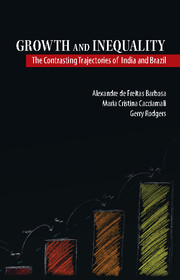Book contents
- Frontmatter
- Contents
- List of Tables
- List of Graphs and Maps
- Preface and Acknowledgements
- List of Abbreviations
- 1 Brazil and India: A Mirror Image of Each Other?
- 2 Approach and Method
- 3 Brazil and India in the Decades before 1980
- 4 India and Brazil from 1980 until 2014
- 5 Key Divides and Cleavages: Ruptures, Continuities, or Adaptation?
- 6 Inequality in Social and Economic Context
- 7 Post-Script
- Bibliography
- Index
2 - Approach and Method
Published online by Cambridge University Press: 02 August 2019
- Frontmatter
- Contents
- List of Tables
- List of Graphs and Maps
- Preface and Acknowledgements
- List of Abbreviations
- 1 Brazil and India: A Mirror Image of Each Other?
- 2 Approach and Method
- 3 Brazil and India in the Decades before 1980
- 4 India and Brazil from 1980 until 2014
- 5 Key Divides and Cleavages: Ruptures, Continuities, or Adaptation?
- 6 Inequality in Social and Economic Context
- 7 Post-Script
- Bibliography
- Index
Summary
Why compare Brazil and India? Can this duo provide a meaningful comparison that will help to explain the patterns and trends of inequality within each country?
Brazil and India have different social structures and histories, the urban/rural divide is expressed in quite different ways, and their labour markets have different shapes – for instance, in the nature of segmentation and in the importance and role of informal work. Moreover, the patterns of international economic integration are dissimilar, as well as some of the drivers of economic growth and how these have changed over time.
However, there are common elements too. Both countries underwent a process of industrialization on the periphery of the world economy, led by the state, which not only modified their position in the international division of labour, but also brought about deep social changes and ruptures. Both countries had break points at similar dates in their development process – first in the 1930s (Brazil) or the 1940s (India), and then in the 1980s for both. After the 1980s, both economies liberalized, at different speeds and in different ways, while maintaining an important economic role of the state. This changed the dynamics of the economy and the labour market, especially after 2000, when the comparison is particularly interesting, because the main outcomes in terms of inequality diverged, although both economies increased their engagement with the global economy.
Even though different political settings prevailed after the 1980s, Brazil and India were both stable democracies during this period, with more or less solid institutions, allowing for a public debate over their development strategies. The role of the state, the size of the internal market, a significant position in the global economy, and a vibrant and fast-changing civil society demanding redistribution are some other points they have in common. This combination is not generally found in other developing countries.
For a comparison to be productive, the differences need to be understood as well as the similarities, and care is required in interpreting apparently similar patterns that may in fact have different origins and natures. Also the framework of analysis needs to be the same for both cases. But comparative analysis of this type provides additional degrees of freedom and a perspective on social and economic relationships that is relative rather than absolute.
- Type
- Chapter
- Information
- Growth and InequalityThe Contrasting Trajectories of India and Brazil, pp. 11 - 18Publisher: Cambridge University PressPrint publication year: 2017



